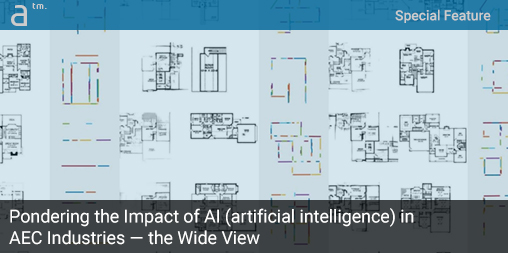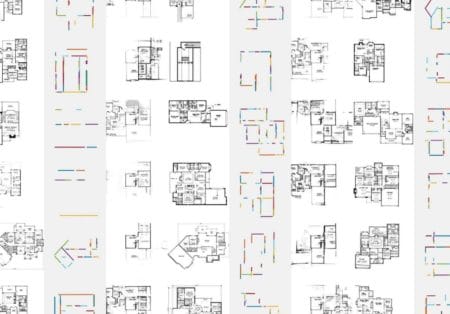Continued from page 1
What’s Possible with AI and ML and Can Everyone Have Better Buildings?
AI, ML, and big data and other emergent technologies (emTech) can radically reshape the field of architecture and the way society sees architects. But such a change will run up against dominant cultural norms and assumptions about the profession. Perhaps before settling into questions about what is possible with AI and ML technologies we examine instead the question that comes up in Hauck’s industrial analogy. When he talks about the wrong type of economic scarcity the question that comes to mind is, thanks to AI and ML, can everyone have better buildings and not just a small percentage of society—not only the elite?
“There is an abundance of capital in the world and a shortage of quality housing, offices, and maintenance of these structures,” says Radu Gidei, associate development lead at Enstoa in London. Gidei is a BIM and computational design specialist who has written an AI Dynamo package where users can bring in a full ML (machine learning) workflow in four nodes. Enstoa is a leading systems integrator for capital projects worldwide. “The money is not going towards buildings; it is going into other investments because it is too risky to build now.”
Advertisement
“Isn’t it also related to how we build today,” states Galanos. “I am not a margin expert, but it seems we can work for many years under all this stress and only for making a single percent gain.” There is no debating that capital building expenditure comes with substantial risk, but that may be where AI and ML serve a significant role in the near future. Hauck remains skeptical though that technology alone, even with AI and ML, can solve the essential problem of democratizing good architecture or good buildings for masses. “There is an article I read recently that asks, ‘Why Technology Hasn’t Fixed the Housing Crisis,’ and it turns out that the housing crisis isn’t because of the buildings. It turns out there is this whole infrastructure of how housing works, and it has nothing to do with the physical world other than the allocation of land. So unless you change that companies like Katerra are not going to solve the housing problem.”
The New York Times piece mentioned by Hauck boils it down to policy change. But policies aside, the construction industry is regularly hounded for its tremendous inefficiencies which drive up costs. Katerra may not solve the affordable quality housing crisis on its own without policies, but the company’s radical new approach may make significant advancements. Katerra approaches the design and building process as one single thread rather than the disparate and discrete sets of processes that exist today. They use the very latest technologies, taking digital design direct to fabrication to save time—the AEC industry’s single biggest cost driver. They also employ data scientists and AI experts.
Katerra represents the type of upheaval to the AEC industry that is possible in the age of AI. I mean this in positive terms. And it may ultimately lead to the solution vector that allows all of society to benefit from high-quality architecture and performant buildings. But there are other variables at play that shape factors of convergence that can lead to improvements in the built environment. One of those is data.
Where will architects get this data? This is where IoT (Internet of Things) and sensors come into play, and it marks a significant opportunity space in AEC. Our panel’s expertise is in computational design, but connecting sensors and the roles these devices play in the future of architecture is quite fascinating.
“Now you are talking about where my heart beats,” says Natasha Bajc, “this is where we enter the realm of Ambient Intelligence, understanding the mash-up of sensors, data, human response systems, et cetera, and capturing the user’s experience of space on so many levels. What is a comfortable space?” she finishes.
“A really simple mechanism could be used to help answer that question,” says Keough, “and I see it pop up in more and more places. Most recently I was at the port authority in New York, and the Port Authority bathrooms are notoriously bad. Well, now they have cleaned them up a bit and what you have when you leave the bathroom is you encounter this panel with this frowny face-to-happy face icon on them. I think this is one of the most brilliant data acquisition play in the built environment, and it’s not complex, it’s not IoT, it’s just this simple 1-4 range of faces that collect data on how people rate this space.” [see the link to the company] Keough says these types of low-tech devices could collect millions and millions of data points, offering building owners useful data impacting the buying process that can be fed back to the design stage. AI and ML acting on this data can further inform insight and discover patterns that ultimately lead back to answering Bajc’s question of what is a comfortable space. “There are all kinds of new and interesting models that can come about,” adds Keough, “tying that data acquisition piece back to the phases of design. Those companies just don’t exist yet.”
You start to have this DNA of a building, this genome, and you map it out. Now you can recall it whenever you do a simulation. Or you can have this blank canvas and say, I have the outcome I want, what would the base need to be to achieve it?
“But we are starting to get a few of them,” says Radu Gidei. “If you take that quality data that you take from the frowny faces and you add the dimension of IoT sensors on top of it, so it becomes this multi-modal system, this ensemble that Natasha talks about, you start getting a pretty good view of what is going on, what caused what, and outlier detection and all that. So now you have this understanding of what causes the root causes of people’s unhappiness or happiness in buildings. So what is the next step? You start to have this DNA of a building [or building type] this genome, and you map it out. Now you can recall it whenever you do a simulation. Or you can have this blank canvas and say, I have the outcome I want, what would the base need to be to achieve it?”
Whether the goal is achieving happy occupants of public toilet rooms or occupant well-being in homes or hospitals, the role of data in formulating strategies that lead to instantiating the conditions that will guarantee it is vast. This is where our mobile devices will ultimately come into play. Companies like Nemetschek’s SpaceWell imagines a cycle that passes through IoT and smart buildings to occupant comfort and performance data to property and real estate data that ultimately feedback design as quantitative and qualitative data. Apps that allow occupants to book conference rooms in offices can easily let them rate those spaces. Social media has trained society to “like” and “dislike” things at the click of a button. But does this type of cloud-sourced data indeed help us become better designers—even if AI and ML have parsed through masses of it to form patterns for success?
The Education of Future Architects in the Era of AI and ML
This is an interesting question, but its answer will lie with the future of architectural education. And it’s important to note that we are at very early stages. Among the panel of experts in this article, there seems to be a broad consensus that AI, ML and computational design in general—while profoundly critical to advancing the state of the art of the profession—are not the be-all and end-all for educating the next generation of the profession. But AI, ML, and data will all definitely upend what architects do because they challenge the reign of intuition and confront our field’s collective assumptions.
There was a study that looked at engineering education when it took out sociology and philosophy, what they discovered was engineers were unable to create new knowledge.
Gidei feels that the AI and ML-infused software tools that architects will use in the near future need to form a type of conversation with the designer. “We will need systems that introduce surprise, the way humans do in design studios where a person walks up and says ‘what about this?’ or ‘how about this one?’ ”
The other issue is the design of process and representation systems. “The design of the representational space is useful in framing the problem,” says Bajc, “so I don’t think we as a discipline pay enough attention to this. If you only work in sections, your answers will always give you another profile.” She warns that our brain is naturally reductionist, “it’s a virtual reality reduction machine.” If how you frame the problem is how you see the world there is the danger that framing problems through algorithms and AI may lead to unanticipated results.
“A few years ago we started hearing about academics complaining how all the projects were converging on a particular style,” adds Hauck, “because they were all sharing cool but common algorithms.” “That’s right, among experts in computational design we have found that we can chase back a design to a particular script,” says Gidei. The issue with algorithms, says Hauck, is that they are massively reductionist.

04 – Another example of Hypar, a scalable computational offering—platform—for the AEC industry. You can learn more here and in our report and in other sections of the Xpresso newsletter.
It seems that many computational designers enter the field of architecture through STEM fields now. Gidie is one example. “I had a background in programming before architecture school… I went to architecture school to learn how to think differently. I saw it as this last kind of universal profession or Renaissance Man.” Both Natasha Bajc and Theodore Galanos had conflicting views on the type of thinking that should be encouraged in architecture school, with Bajc pushing for more analytical thinking and Theodore for more dialectical thinking.
“There was a study that looked at engineering education when it took out sociology and philosophy,” says Galanos, “what they discovered was engineers were unable to create new knowledge.” Galanos wasn’t the only engineer on the panel but has three masters degrees in engineering, ecology and sustainability fields. “I think coding is overestimated and underestimated,” he adds. “I’m not a very good coder, per se, and I don’t think you need to be a programmer type to be hired in an AEC company of the future. What you need to understand is what coding can do.”
Closing Thoughts
The future of architecture in the era of AI and ML is uncertain at best. Even companies like Katerra have designers and architects on staff. But they have far more engineers across every category affecting AEC, manufacturing, and software development. They also have AI engineers and are using machine learning (ML) by working with AI and data scientists to develop new types of algorithms. It remains to be seen what type of innovations Katerra brings to the AEC world through coding and AI-ML. And another question is: will they share it like what is so common among the computational design community in AEC today? Reading their job postings can be illuminating and fascinating. One sees very closely that their various technical positions demand horizontal thinking and knowledge of the full-stack.
In 1955, the architectural equivalent of “knowledge of the full-stack” for an architect would mean being knowledgeable about architectural history, being a capable designer, being able to develop a set of construction documents, being a competent communicator, and finally being knowledgeable about buildings. Full-stack training could have begun with carpentry stints during high-school or college, being taken to the museum as a child to learn about design and art, or fortunate enough to grow up in a wealthy family that traveled around the world to see architectural history first hand. Back then full-stack meant the acquisition of knowledge captured by doing and direct exposure. AI and ML tools are going to provide architects, young and old, with lots of data and information, but is this the same as knowledge?
It won’t be the codes or the coders or the output of the algorithms that will become celebrated stars, but rather the radically new business models that will come out of it—the new responses the code, ML infused, enables us to achieve.
IBM—yes, that IBM—has a great article series that explains how data becomes knowledge. In a nutshell, data is simply a collection of facts, signals or symbols. It can be raw, inconsistent, and even disorganized. Information is a collection of data that has been “arranged and ordered” in a consistent way. Data in this form becomes more useful because of storage and retrieval. The architectural equivalent might be a window or door schedule in a set of working drawings. It could also be the set of elevation markers on a site contour map. Knowledge, says this IBM series, is a collection of “information”—note, not a collection of “data”—with its associated context. Context defines the form of relationship between information sets over time. Time is a critical piece because over long periods of time data accumulation gets so vast that it is impractical for humans to manually determine and unlock these relationships. This is where AI and ML offer power.
Advertisement
Importantly for the context of this article, the IBM series notes that: “Knowledge is the application of information to answer a question or solve a problem.” But Wisdom, “is the ability to select the best way” to reach the desired outcome. We already see AI’s beating grandmasters at complex games like Go. In 2017, Google’s AlphaGo defeated 19-year-old Ke Jie, a grandmaster of the Go game, reports an NPR article. ” ‘Last year, it was still quite humanlike when it played,’ Ke said, ‘But this year, it became like a god of Go.’ ” So artificial intelligence (AI) is aiming high—reaching for Wisdom.
Architecture in the era of AI and ML is likely going to be the final nail in the coffin for the pre-21st century model of architectural practice. But not necessarily architectural practice itself. Without data and AI and ML and computational design and simulation, architects use years of knowledge and intuition as the primary value-set behind what they do. “Design today is guessing the effect of something in prospect,” says Anthony Hauck. It’s not that intuition goes away, it now needs to combine with data that moves to insight-based AI-patterned information that is testable and actionable by architects. This will form the new pathway to knowledge in the field, but the new pathways may require new modes of working in the industry. Will there still be ‘starchitects’—a new coder type perhaps—along with the media setting the goal posts in the industry? “It won’t be the codes or the coders or the output of the algorithms that will become celebrated stars,” says Gidei, “but rather the radically new business models that will come out of it—the new responses the code, ML infused, enables us to achieve.”
End Notes
Look for more information on these panel participants and their work, and ML and AI technologies, in general, inside our new INSIDER Xpresso (monthly) newsletter. You can get the first issue here (sign-up) its free!






Reader Comments
Comments for this story are closed